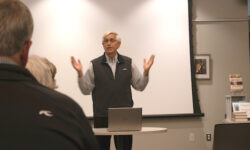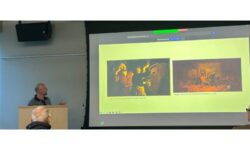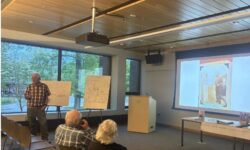[ccfic caption-text format="plaintext"]
By Amelia Tarallo
Hometown Weekly Staff
Bath time is usually easier for kids when they have something with which to entertain themselves.
Some parents invest in bubble baths, so their kids can put on fake beards and soapy wigs. Others invest in tub toys, like plastic fish or dolls, for their children to play with. For years, though, the clear winner in the tub entertainment department has been the classic rubber ducky. Its yellow figure floating on top of the water, orange beak, and bright eyes - plus its squeaking noises - makes it a bathtub favorite for all.
Children visiting the Sherborn library on May 2 had the chance to make their own soap versions of the classic bath toy.
The activity was led by Garney, a professional soap maker who specializes in making glycerin-based soaps. “This soap is humectant. Does anyone know what that means?” Garney asked. Once child suggested that it attracts water. “That’s right. It attracts moisture from the air,” answered Garney.
Children making their soaps began with their first step of obtaining blocks of pre-sized glycerin. They then took knives and used them to chop the larger blocks of glycerin into tiny cubes. “The knives are dull so you won’t cut yourself,” noted Garney, clearly more as an assurance for worried parents than for their kids.
Kids then brought their cut-up glycerin blocks to the microwave, where an adult would help melt them down. “It’s okay if it’s still got some chunks, as long as they’re small chunks,” said Garney.
While they waited for their glycerin cubes to melt down into a gel-like consistency, kids picked out their choice of animal figurine and the essential oils that they would use in its creation. “It’s very strong, so we only need about six drops,” noted Garney. The children had a choice between a rubber ducky with rabbit ears or a cute, classic rubber ducky. Many of the children opted for the rubber ducky with rabbit ears, inspired by the recent celebrations of Easter. The kids were told to be careful as they carried back their figurines and melted glycerine, so as to avoid burning themselves. “Carry it carefully. If it falls, just let it go,” explained Garney, “I can clean up the glycerin, but I can’t fix any burns.”
Once their glycerin was melted, the children returned to their seats, where they began the fun part of the project. At the beginning of the workshop, Garney informed the children that they would get the chance to add smells (using essential oils), colors, and much-coveted glitter powder to their soap creations. She carefully went over what colors the kids could make by combining different primary colors. “What are your primary colors?” she asked. One child noted that it they were red, blue, and yellow. “That’s right! Now, what colors do you use to make orange?” Garney asked.
“Red and yellow!” one child replied. He was correct.
“How do you make purple?” one girl asked.
“You use red and blue,” Garney answered.
For the kids, choosing the colors for their soaps was just as fun as opting for a rabbit or duck. Eleni enjoyed adding red glitter and red dye to her soap, keeping hers a consistent color. One child went down a more creative route, adding a drop of every dye and glitter available, creating a metallic rose gold color for his soap base. “That’s pretty,” one parent commented.
After mixing together their choice of essential oils, dye, and glitter, the children reached the hardest part of their project: adding the waves. Garney had cut up some small, curly green pieces of soap, called waves, before the start of the program for the kids to use for this step. Carefully using a small wooden stick, the children propped their rubber duckies up so that they didn’t sink to the bottom of their soap base. “It only looks like water,” one parent explained to her son after he wondered why his duck wasn’t floating. “I think you need more waves,” another suggested to her child. As they added the tiny waves, the children were mesmerized at how their soap was beginning to look just like the examples they had seen at the start of the program.
“Your soaps should be ready to use by tomorrow morning,” said Garney at the end of the program.
In less than 24 hours, the children could pop the soaps from their cup molds and use them, making bath times in town that much more entertaining.























